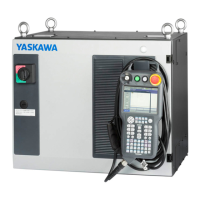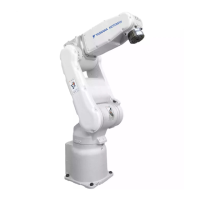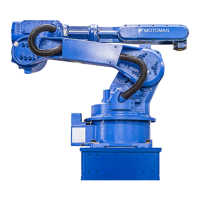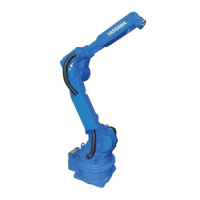System Setup
9 - 118
<Example 2>
The moment of inertia must be set at the center of gravity if the total size of the tool and
workpiece is large compared to the distance between the flange and the center of gravity.
Calculate the moment of inertia at the center of gravity roughly on the basis of the formula
(see the moment of inertia for hexahedron and cylinder above). The whole tool is
approximated to the shape of the hexahedron or cylinder.
If the weight of the workpiece being held varies greatly (e.g. in handling), it is advisable to
set the tool load for each workpiece and to switch the tool on at every step depending on
the workpiece being held. Set the tool load with the heaviest workpiece if the tool is not
switched on.
Weight: W = 55 + 40 = 95 = approx. 100 kg
Centre of gravity: Position on the flange directly under 250 mm
(Xg, Yg, Zg) = (0, 0, 250)
Moment of inertia at the center of gravity:
A hexahedron with dimensions of 0.500 x 0.400 x 1.000 m is assumed, which encloses the
entire tool and workpiece. Calculation formula for calculating the moment of inertia of the
hexahedron:
Calculation of the center of gravity and moment of inertia at the center of gravity for multiple
loads.
The center of gravity and moment of inertia at the center of gravity of the whole tool can be
calculated on the basis of the weight and center of gravity of each load if the tool consists
of one or more heavy parts (e.g. double welding gun).
Tool weight: approx. 55 kg
Workpiece weight: approx. 40 kg
Ix = (Ly2 + Lz2 / 12) * W = ((0.4002 + 1.0002) / 12) * 100 = 9.667 = approx. 10.000
Iy = (Lx2 + Lz2 / 12) * W = ((0.5002 + 0.4002) / 12) * 100 = 3.417 = approx. 3.500
Iz = (Lx2 + Ly2 / 12) * W = ((0.5002 + 1.0002) / 12) * 100 = 10.417 = approx. 10.500
<Setting>
W : 100,000 kg
Xg : 0.000 mm
Yg : 0.000 mm
Zg : 250,000 mm
lx : 10,000 kgm²
ly : 3,500 kgm²
lz : 10,500 kgm²
1
250
1000
400
500
XF
ZF
YF
1
2
2

